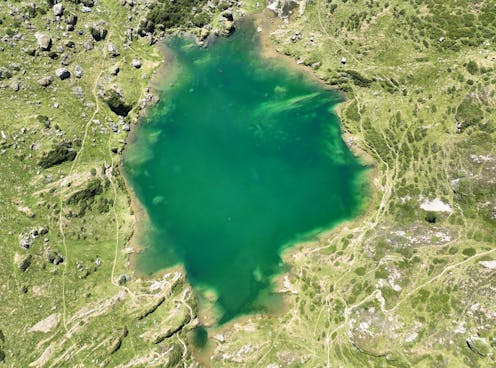 The Ayès lake, in the Ariège region of the Pyrenees. Dirk S. Schmeller, Fourni par l'auteur
The Ayès lake, in the Ariège region of the Pyrenees. Dirk S. Schmeller, Fourni par l'auteurI first set foot in the Pyrenees in 2006. Two years later, I began a large-scale survey of mountain lakes and amphibian populations: from east to west, I covered more than 100 mountain lakes located in the eastern Pyrenees to the Béarn region (Pyrénées-Atlantiques).
For our various projects, we came back to sample the same lakes at least once a year. Over time, we noticed changes, in particular the increased growth of algae cyanobacteria and sometimes dinoflagellates, the blue-green algae that turn many lakes green. Back in 2012, we informed the Pyrenees National Park (PNP) about our observations.
Over the years, I’ve seen many of these lakes change colour. Some have lost the clarity and blue we’ve all come to expect from a mountain lake, while others have started to take on a greenish hue or even a bright green, particularly at the end of summer.
This trend does not affect any one region more than another: it can be found in the Ariège Pyrenees, the central mountains of the Pyrenees, as well as the western Béarn region. This is not a rare, localised phenomenon, but a large-scale event that is set to spread over the coming years. We’re also seeing it on the other side of the border, in the Catalan Pyrenees, where my colleague Marc Ventura has been leading the European Limnopirineus project.
In the Alps, colleagues at the research centre for high-altitude ecosystems (in French: Centre de recherche des écosystèmes d’altitude, Crea) have made a similar observation. Even in the Canadian Rockies, a clear growth in algae has been observed.
We have identified four main causes of this greening of the lakes.
1. More fish and algae, fewer crustaceans
On the Catalan side, Marc Ventura first noticed that the presence of fish was contributing to the phenomenon, and that their eradication was turning the lakes back to a bluish hue. For those of you who might have a problem with the idea of “eradication”, it should be pointed out that the presence of fish in mountain lakes is not natural: it is the result of fish stocking carried out to promote recreational fishing.
To better understand the mechanisms at work, it is important to realise that the species present in mountain lake communities form a highly complex system, with a bewildering number of interactions. The disappearance of one species or a group of species from an aquatic system can lead to radical changes of the overall ecosystem (in this case, a mountain lake).
In the lakes studied, for example, it was observed that crustaceans were much less numerous or even absent in the presence of fish, particularly minnows, a very commonly introduced species in mountain lakes. Microcrustaceans in aquatic ecosystems filter water to ingest food, which is essentially made up of algae: in their absence, this imbalance allows algae to proliferate.
2. Insecticides that kill crustaceans
According to our own work carried out in certain lakes, the absence or sharp reduction in crustaceans is also due to pollution. It is thought two insecticides in particular shoulder the blame: permethrin and diazinon, which are either used on livestock to protect them from stinging insects or are present in insect repellents used by tourists.
We have identified many other chemical molecules in lake water – 141 in total – and the effect of this cocktail on aquatic food webs is currently unknown. It should be noted, however, that we are currently only able to detect a small proportion of the organic molecules, due to methodological limitations. The cumulative toxicity of all the pollutants emitted by humans in these environments therefore remains a mystery.
It is therefore likely that we are underestimating the overall impact of the large number of organic molecules on aquatic ecosystems in the mountains and elsewhere. But there is no doubt that, in the lakes we are studying, the increase in pollution is encouraging the disappearance of microcrustaceans and therefore the proliferation of algae.
3. Livestock waste, nutrients for algae
Research has indicated pollutants may come from livestock, which are treated against biting insects with Butox or similar veterinary treatments containing deltamethrin or permethrin. Applied to the skin, these insecticides penetrate the animal’s bloodstream before being excreted in urine and faeces.
The active molecule remains largely unchanged and enters the water, even though it is highly toxic to crustaceans in mountain lakes starting from a concentration of the order of a few nanograms per litre, which is tiny. By killing crustaceans, these insecticides profoundly alter the aquatic food web.
But that’s not all. Algae also need nutrients to grow. Cattle provide them by drinking from lakes before urinating and defecating in the water: these discharges contain a high concentration of nutrients (nitrates and phosphates, among others), and especially phosphates are needed by cyanobacteria, filamentous algae.
4. Climate change
Finally, algae appreciate the heat: they multiply with high growth rates during the summer months, particularly when the water temperature exceeds 20°C. The rise in temperature caused by climate change is therefore adding to the other factors. In 2022, the edge of Lake Lhurs, in the Béarn region of France, reached over 25°C at an altitude of almost 1,800 metres – a blessing for algae.
These are the main factors, but my research could uncover more in the future. The most important thing is to understand that they act in synergy: we kill crustaceans by introducing fish, we pollute by treating livestock and then, once the mountain aquatic ecosystems have been weakened, we contribute through our activities to increasing the temperature of the lakes: algae then find the ideal conditions for growth. Some of these algae are toxic and therefore present a health risk.
Our lakes thus change from blue to greenish, from greenish to bright green: no mystery to this, their colour simply reveals what we are inflicting on our mountain lakes, our water resources, wildlife, livestock and ourselves.
How to get clear, blue lakes back
Fortunately, all is not lost. The work of Marc Ventura highlights that it is still possible to turn back the clock and return lakes to a blue colour and healthy ecosystems. But this means changing the management of all the mountain lakes.
First, it is essential to limit fish stocking to certain large lakes and ban it in the others, so that they are reserved for local flora and fauna. Even in the large lakes, areas that are inaccessible to fish can be created to encourage invertebrates, amphibians and other aquatic and semi-aquatic species.
The next step is to reduce the pollution caused by tourists, livestock and industry. In particular, by communicating and discussing with the various stakeholders, alerting them to the risks and working with them to find real solutions rather than unsatisfactory compromises.
For example, the Ariège Pyrenees Regional Nature Park has begun to raise awareness among tourists, at least about the use of sun creams. This is a first step, albeit an insufficient one given the range of problems explained here. Another step forward would be to limit cattle access to mountain lakes, which would also help to restore the ecosystems. Finally, on a larger scale, the phenomenon is yet another reminder of the urgent need to combat climate change…

Created in 2007 to help accelerate and share scientific knowledge on key societal issues, the Axa Research Fund has supported nearly 700 projects around the world conducted by researchers in 38 countries. To learn more, visit the site of the Axa Research Fund or follow on Twitter @AXAResearchFund.
The BiodivRestore project is supported by the French National Research Agency (ANR), which funds project-based research in France. Its mission is to support and promote the development of fundamental and applied research in all disciplines, and to strengthen the dialogue between science and society. For more information, visit the ANR website.
Dirk S. Schmeller has received funding from the ANR and AXA Research Fund.

 1 year ago
39
1 year ago
39
